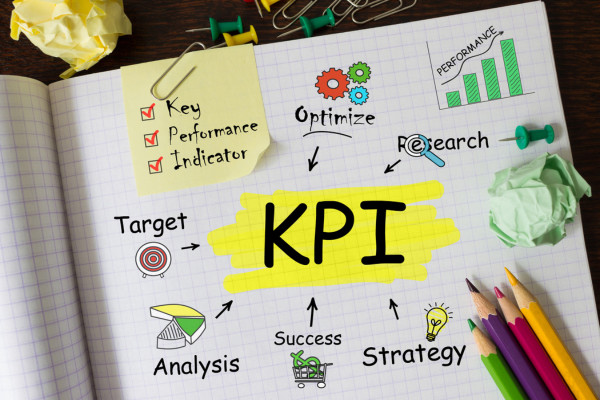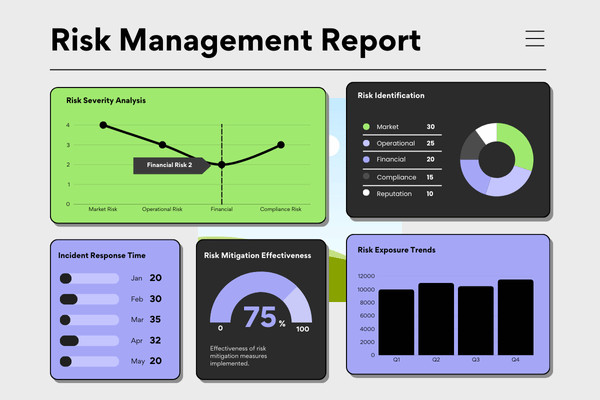
This post is part of the "Strategic Growth Series: 11 Key Operational Areas for Success" series, which covers the 11 essential operational areas that every service-based business needs to master. In this segment - segment #4, I focus on the power of KPIs and how to use them effectively to track business success.
Introduction: In the world of business, success is not just about working hard—it’s about working smart. To ensure your efforts are leading to tangible results, you need a clear way to measure progress and performance. That’s where Key Performance Indicators (KPIs) come into play. KPIs are powerful tools that help you track your business’s success, identify areas for improvement, and make informed decisions that drive growth. In this post, I’ll explore the power of KPIs, why they matter, and how to use them effectively in your business.
Section 1: What Are KPIs and Why Are They Important? Key Performance Indicators (KPIs) are measurable values that indicate how well your business is achieving its key objectives. They provide a clear picture of your business’s performance in critical areas, helping you understand what’s working and what needs improvement.
- Monitor Progress: KPIs allow you to track your progress toward specific business goals, ensuring that you stay on course and make adjustments as needed.
- Improve Decision-Making: By providing concrete data, KPIs enable you to make informed decisions based on real-time insights rather than guesswork.
- Drive Accountability: KPIs help establish clear performance expectations for you and your team, fostering a culture of accountability and continuous improvement. For entrepreneurs, this means setting your own performance standards and tracking your progress toward those goals.
- Support Strategic Planning: KPIs align with your overall business strategy, helping you measure the effectiveness of your initiatives and adjust your approach as needed.
Section 2: How to Choose the Right KPIs for Your Business. Choosing the right KPIs is crucial to effectively tracking your business’s success. Here’s how to identify the KPIs that matter most:
- Align with Business Goals: Start by identifying your most important business goals, such as increasing revenue, improving customer satisfaction, or enhancing operational efficiency. Your KPIs should directly align with these goals.
- Example: If your goal is to increase customer retention, a relevant KPI might be the customer retention rate or customer satisfaction score.
- Focus on Key Metrics: Avoid the temptation to track too many KPIs. Focus on a handful of key metrics that have the greatest impact on your business’s success.
- Example: For a service-based business, key KPIs might include client acquisition cost, average revenue per client, and client retention rate.
- Make KPIs Measurable and Actionable: Choose KPIs that are easy to measure and provide actionable insights. This ensures that you can track progress accurately and make informed decisions.
- Example: Instead of a vague KPI like “improve marketing,” use a specific, measurable KPI such as “increase website conversion rate by 15% over the next quarter.”
- Review and Adjust Regularly: KPIs should not be static. Regularly review your KPIs to ensure they remain relevant and adjust them as your business goals evolve.
- Example: If you introduce a new service offering, you might need to add or adjust KPIs to track its performance.
Section 3: How to Use KPIs Effectively. Once you’ve identified the right KPIs, the next step is to use them effectively to drive business success:
- Set Clear Targets: Define specific targets for each KPI, so you know what success looks like. These targets should be challenging yet achievable.
- Example: Set a target to reduce customer acquisition costs by 10% within six months.
- Monitor KPIs Regularly: Track your KPIs on a regular basis—whether it’s weekly, monthly, or quarterly—depending on the metric. Regular monitoring allows you to identify trends and address issues promptly.
- Example: Review your KPIs in monthly team meetings or with a trusted advisor to assess progress and discuss strategies for improvement.
- Analyze and Interpret Data: Use your KPIs to analyze and interpret business performance. Look for patterns, trends, and correlations that can inform your decisions.
- Example: If you notice a dip in client satisfaction scores, investigate the root cause and take corrective action.
- Communicate with Your Team: Share KPI data with your team or other relevant stakeholders to keep everyone aligned and focused on key business objectives. Use KPIs to drive accountability and foster a results-oriented culture.
- Example: Display KPIs on a dashboard or in meetings to keep everyone informed of progress and areas needing attention. For solopreneurs, this might mean reviewing your KPIs regularly with trusted advisors or mentors.
Section 4: The Benefits of Tracking KPIs. Tracking KPIs effectively offers numerous benefits to your business:
- Enhanced Performance: By continuously monitoring KPIs, you can make data-driven adjustments that improve performance and drive growth.
- Improved Resource Allocation: KPIs help you allocate resources more effectively, focusing on areas that yield the highest returns.
- Greater Agility: Regular KPI tracking enables you to quickly respond to changes in the market or business environment, keeping you agile and competitive.
- Increased Accountability: Clear KPIs create a culture of accountability, where everyone knows what’s expected and works toward common goals.
Conclusion: KPIs are powerful tools that can help you track your business’s success, make informed decisions, and drive growth. By choosing the right KPIs, setting clear targets, and regularly monitoring progress, you can ensure that your business stays on the path to success.
FREE RESOURCE
Ready to take the guesswork out of tracking your business’s success? Download my FREE Business Strategy Self-Audit Workbook by clicking HERE. This comprehensive guide covers all 11 essential operational areas every service-based business must master—including KPIs and performance tracking. Use it to identify the key metrics that matter most for your goals and build a strategy that ensures measurable, sustainable growth.
JOIN THE CONVERSATION!
What are the key metrics you track to measure success in your business? Have you faced any challenges in identifying or monitoring the right KPIs? Share your insights and experiences in the comments—I’d love to hear how you’re using data to drive growth and stay on track with your goals!

This post is part of the "Strategic Growth Series: 11 Key Operational Areas for Success" series, which covers the 11 essential operational areas that every service-based business needs to master. In this segment - segment #3, I focus on the power of regular strategic reviews and continuous improvement to ensure long-term success.
Introduction: In today’s fast-paced business environment, standing still is not an option. To stay competitive and achieve long-term success, service-based entrepreneurs must regularly assess their strategies and continuously seek ways to improve. Regular strategic reviews and a commitment to continuous improvement are essential practices for anyone wanting to remain agile, responsive, and successful. In this post, I’ll explore the power of strategic reviews and continuous improvement, why they are crucial, and how to implement them effectively in your business.
Section 1: Why Regular Strategic Reviews Are Essential. Strategic reviews involve assessing your business strategy to ensure that it aligns with your current goals, market conditions, and performance. Here’s why regular reviews are so important:
- Adaptation to Change: The business environment is constantly evolving. Regular strategic reviews allow you to adapt your strategy to new market conditions, customer needs, and competitive pressures.
- Alignment with Goals: As your business grows and evolves, your goals may change. Strategic reviews ensure that your business strategy remains aligned with your current objectives.
- Identification of Opportunities: By regularly reviewing your strategy, you can identify new opportunities for growth, innovation, and improvement that may have been overlooked.
- Mitigation of Risks: Strategic reviews help you identify potential risks and challenges early, allowing you to take proactive measures to mitigate them.
Section 2: The Role of Continuous Improvement. Continuous improvement is the ongoing effort to enhance your services, processes, and strategies. It’s about making small, incremental changes that lead to significant long-term results. Here’s why continuous improvement matters:
- Enhanced Efficiency: Continuous improvement helps you streamline processes, reduce waste, and improve efficiency, leading to cost savings and better resource allocation.
- Increased Competitiveness: By continuously improving, you stay ahead of competitors, offering better services and customer experiences.
- Personal and Professional Growth: A culture of continuous improvement encourages your own development, as well as the growth of any team members, leading to more innovative and effective service delivery.
- Sustained Growth: Continuous improvement fosters a mindset of learning and adaptation, ensuring that your business remains dynamic and capable of sustained growth.
Section 3: How to Conduct Effective Strategic Reviews. To get the most out of your strategic reviews, follow these steps:
- Set Clear Objectives: Determine what you want to achieve with your strategic review. Are you looking to align with new goals, address performance issues, or explore new opportunities?
- Example: Set an objective to evaluate the effectiveness of your current client onboarding process and identify areas for improvement.
- Gather Data: Collect relevant data on your business’s performance, client feedback, and market trends. This data will inform your review and help you make data-driven decisions.
- Example: Analyze client feedback, review your service delivery timelines, and assess market trends to gain insights into your current performance.
- Involve a Peer Group or Mentor: If you don’t have a leadership team, consider involving a peer group, mentor, or business strategy coach in the review process. Their outside perspective can provide valuable insights and help you identify blind spots.
- Example: Discuss your strategic review findings with a business strategy coach or mentor to gain additional perspectives and advice on potential improvements.
- Analyze and Evaluate: Review the data and feedback you’ve collected to identify strengths, weaknesses, opportunities, and threats (SWOT analysis). Assess whether your current strategy is still relevant and effective.
- Example: Conduct a SWOT analysis to evaluate your current service offerings and identify areas that need adjustment or innovation.
- Develop Action Plans: Based on your analysis, develop action plans to address any gaps or opportunities. Set clear goals, timelines, and responsibilities for implementing these changes.
- Example: Create an action plan to enhance your client follow-up process, with specific goals for increasing client satisfaction and retention.
Section 4: How to Foster a Culture of Continuous Improvement. To embed continuous improvement into your business culture, consider these strategies:
- Encourage Idea Generation: Create a system where you can regularly assess your processes and service offerings. Regular self-reflection and client feedback are crucial.
- Example: Schedule monthly or quarterly reflections where you evaluate your service delivery and identify areas for improvement based on client feedback.
- Implement Small Changes: Focus on making small, incremental changes that are easier to implement and sustain. Over time, these small changes can lead to significant improvements.
- Example: Introduce a new tool to automate client communication and see how it impacts your efficiency and client satisfaction.
- Monitor and Measure: Track the impact of continuous improvement initiatives to ensure they are delivering the desired results. Use KPIs (Key Performance Indicators) to measure progress and make adjustments as needed.
- Example: Monitor client satisfaction scores and project completion times to gauge the success of your improvement efforts.
- Promote a Learning Culture: Engage in continuous learning by seeking out new skills and knowledge relevant to your industry. This will help you stay on the cutting edge and drive continuous improvement.
- Example: Take online courses or attend workshops to keep your skills sharp and your business practices up-to-date.
Conclusion: Regular strategic reviews and a commitment to continuous improvement are powerful tools for driving business success. By regularly assessing your strategy and making incremental improvements, you can ensure that your business remains agile, competitive, and positioned for long-term growth.
FREE RESOURCE
Ready to stay agile and drive long-term growth in your business? Download my FREE Business Strategy Self-Audit Workbook by clicking HERE. This comprehensive guide covers all 11 essential operational areas every service-based business must master—including Strategic Reviews and Continuous Improvement. Use it to assess your current strategies, uncover areas for enhancement, and ensure your business remains dynamic, competitive, and successful.
JOIN THE CONVERSATION!
How often do you review your business strategies and make improvements? What challenges have you faced in staying consistent with this process, and how has it impacted your business growth? Share your experiences in the comments—I’d love to hear how you approach continuous improvement and connect with you!

This post is part of my "Strategic Growth Series: 11 Key Operational Areas for Success", which covers the 11 essential operational areas that every service-based business needs to master. In this segment - segment #2, I focus on the critical role of innovation as a key for staying ahead of the curve.
Introduction: In today's competitive and ever-evolving market, standing still is no longer an option. For entrepreneurs in the service sector, innovation is not just a buzzword but a key driver of business growth. Whether it's refining your service offerings, optimizing processes, or adopting new technologies, innovation is essential for staying ahead of the curve. In this post, I’ll explore how embracing innovation can help you grow your business, and I’ll share actionable strategies to keep your business adaptable, competitive, and thriving.
Section 1: The Importance of Innovation in Business Growth Innovation allows businesses to adapt to changing market conditions, meet evolving customer needs, and differentiate themselves from competitors. By embracing innovation, you can:
- Enhance Service Offerings: Innovation helps you create new or improved services that better meet your clients' needs.
- Increase Efficiency: Streamlining operations through innovative processes can reduce costs and improve productivity.
- Stay Competitive: Continuous innovation ensures that your business remains relevant and can outpace competitors.
- Foster Client Loyalty: By offering innovative services or experiences, you can build stronger relationships with clients and increase retention.
Section 2: Strategies for Embracing Innovation in Your Business. Here are some practical strategies you can use to incorporate innovation into your business and drive growth:
- Continuously Listen to Your Clients: Keep an open line of communication with your clients to understand their evolving needs. Use feedback to refine your services and adapt to their preferences.
- Example: Conduct regular surveys or feedback sessions to gather insights on how your clients view your services and what improvements they would like to see.
- Leverage Technology: Technology is one of the most powerful tools for innovation. From automation tools to CRM systems, the right technology can help you streamline operations, enhance client interactions, and deliver your services more efficiently.
- Example: Use automation tools for client scheduling, invoicing, or email marketing to free up your time for more strategic tasks.
- Implement Small, Incremental Changes: Innovation doesn’t always require big leaps. Start by making small changes that improve your day-to-day processes or service offerings. These incremental innovations add up over time, leading to significant growth.
- Example: Implement a new client onboarding process that simplifies the experience and reduces the time spent on administrative tasks.
- Invest in Continuous Learning and Development: Stay ahead of industry trends by continuously learning and adapting. Attend workshops, webinars, and conferences to learn about new technologies, trends, and business strategies that can help you innovate.
- Example: Subscribe to industry-related journals or take online courses to stay informed about emerging trends in the service sector.
- Collaborate and Network: Innovation thrives in collaborative environments. Build relationships with other entrepreneurs, and industry professionals. Collaborative partnerships can introduce fresh ideas and lead to innovative solutions.
- Example: Partner with other service providers to create a new service bundle that addresses a specific client need.
Section 3: Overcoming the Challenges of Innovation. While innovation is crucial for growth, it’s not always easy. As an entrepreneur, you might face challenges such as limited resources, time constraints, or fear of failure. Here are some ways to overcome these obstacles:
- Start Small: Focus on one area where innovation can make a significant impact and expand from there.
- Embrace Failure as Learning: Understand that not all innovations will succeed. Use setbacks as opportunities to learn and improve.
- Allocate Time for Innovation: Dedicate specific time each week to work on innovative ideas, whether it’s improving your service offerings or experimenting with new technologies.
Conclusion: Innovation is the cornerstone of business growth, especially for entrepreneurs in the service sector. By embracing innovation, you can stay ahead of the competition, improve your client relationships, and drive long-term success. Start small, stay informed, and be open to change—your business will thrive as a result.
FREE RESOURCE
Ready to unlock the power of innovation and drive growth in your business? Download my FREE Business Strategy Self-Audit Workbook by clicking HERE. This comprehensive guide covers all 11 essential operational areas every service-based business must master—including Innovation. Use it to assess your current practices, uncover opportunities for improvement, and build a strategy that keeps your business adaptable, competitive, and thriving
JOIN THE CONVERSATION!
What’s your biggest challenge when it comes to fostering innovation in your business? How has it impacted your ability to stay competitive and meet your clients' needs? Share your story in the comments—I’d love to hear how you’re tackling innovation and connect with you!









